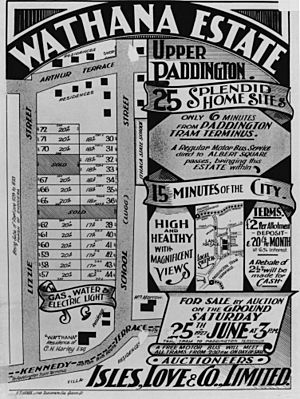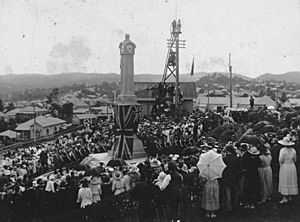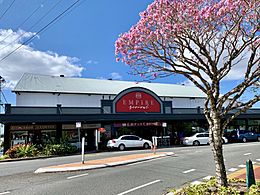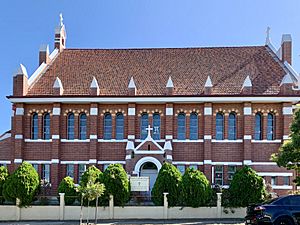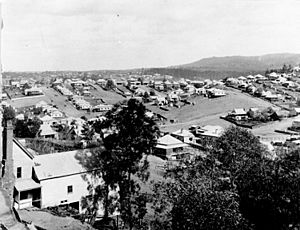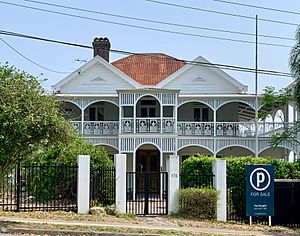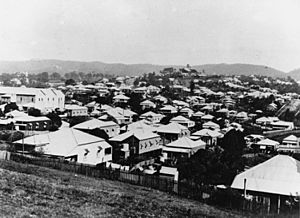Paddington, Queensland facts for kids
Quick facts for kids PaddingtonBrisbane, Queensland |
|||||||||||||||
|---|---|---|---|---|---|---|---|---|---|---|---|---|---|---|---|
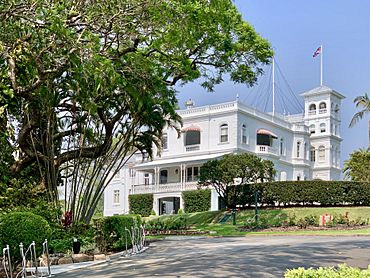
Queensland's Government House, located at 170 Fernberg Road, Paddington, Brisbane, Queensland, Australia
|
|||||||||||||||
| Population | 8,562 (2016 census) | ||||||||||||||
| • Density | 3,420/km2 (8,900/sq mi) | ||||||||||||||
| Postcode(s) | 4064 | ||||||||||||||
| Area | 2.5 km2 (1.0 sq mi) | ||||||||||||||
| Time zone | AEST (UTC+10:00) | ||||||||||||||
| Location | 3.4 km (2 mi) WNW of Brisbane GPO | ||||||||||||||
| LGA(s) | City of Brisbane (Paddington Ward) |
||||||||||||||
| State electorate(s) |
|
||||||||||||||
| Federal Division(s) | |||||||||||||||
|
|||||||||||||||
Paddington is a lively suburb located close to the heart of Brisbane, Queensland, Australia. It's about 2 kilometers (1.2 miles) west of the city center. In 2016, around 8,562 people called Paddington home.
This area is known for its steep hills and ridges. Many unique "Queenslander" style homes, built on tall stumps, can be found here. These stumps help the houses stand strong on the sloped land. Paddington was first settled in the 1860s. The neighborhood of Rosalie is also part of Paddington. It used to be a separate suburb until 1975.
Contents
- Exploring Paddington's Landscape
- A Look Back at Paddington's History
- Who Lives in Paddington?
- Paddington's Culture and Fun
- Getting Around Paddington
- Things to See and Do in Paddington
- Places of Worship
- Education in Paddington
- Paddington's Unique Architecture
- Heritage-Listed Sites
- Important Buildings in Paddington
- Famous People from Paddington
Exploring Paddington's Landscape
Paddington sits in a valley at the base of Mount Coot-tha. The area is very hilly, with many peaks and dips. Most of the shops and businesses are found along the main roads, Given Terrace and Latrobe Terrace, which follow the ridgetops.
Given Terrace starts near Suncorp Stadium and goes uphill to the west. Latrobe Terrace, often called "upper Paddington," also follows a ridgetop. The suburb is mostly residential, with many traditional "Queenslander" homes. These houses often have corrugated iron roofs. Ithaca Creek runs through the area, and early Paddington grew around water holes from this creek.
A Look Back at Paddington's History
The land where Paddington now stands was originally home to the Turrbal people. British settlers knew them as the Duke of York's clan. In the early days, Aboriginal people camped in areas like Armstrong's Paddock.
Early British Settlement
British settlers began arriving in Paddington in the 1850s. The area was first called "Ti-Tree Flats." Early residents came to grow gardens and cut timber. The first land sales happened in 1859. The name "Paddington" came from a farm owned by Mr. B. Clay, who named it after his hometown in London. His farm was sold and divided into smaller plots in 1864.
Petrie Terrace State School opened in March 1868. It started with separate sections for boys and girls. Over the years, the school changed its setup a few times to serve different age groups.
A Primitive Methodist Church opened on Given Terrace around 1877. A new church building was built in 1906, with the old one becoming a church hall. The 1906 church was unfortunately destroyed by fire in 1996.
Paddington was part of different local government areas over time. From 1879, it was part of the Ithaca Division, then the Shire of Ithaca, and later the Town of Ithaca. In 1925, Ithaca joined with 24 other councils to form the Brisbane City Council we know today.
The Morris family ran a boot and shoe factory from the 1880s until the 1960s. At its busiest, the factory employed up to 180 workers. It could make hundreds of pairs of shoes each day! The factory closed in 1973. The building later became a restaurant called "Spaghetti Emporium" and then a nightclub.
Electric trams first came to Brisbane in 1897. A tram line was extended to Paddington in 1898. By 1937, the Paddington tram line reached the suburb of Bardon. A special building for the tramways, called a substation, was built in 1929–30.
In 1898, the Catholic Archbishop Robert Dunne bought land to build Sacred Heart Church. The first Mass was held there by Father Hegarty.
Paddington in the 1900s
Sacred Heart Parish School opened next to the church in 1906. It was run by the Sisters of Mercy. The school closed in 1995 because fewer children in the area needed Catholic education.
In the 1910s, the Ithaca Town Council worked to improve the area. They created Lang Park (1917), the Ithaca Swimming Pool (1917), and the Ithaca Children's Playground (1918). They also planted trees and created gardens along streets. Because of the hilly land, they found it easier to plant gardens on steep slopes rather than flatten them. This made Paddington a leader in street beautification.
On February 25, 1922, Sir Matthew Nathan, the Governor of Queensland, unveiled the Ithaca War Memorial. This memorial honors local people who died in World War I.
In 1927, the water tower at Garfield Terrace was opened. This tower helped provide water to homes on higher ground. For a while, this area was even called Paddington Heights.
Archbishop James Duhig wanted to open a school for boys in Rosalie. Marist Brothers College Rosalie opened on January 28, 1929, with 135 boys. The school was officially opened by Archbishop Duhig. A new school building was opened in 1949. The school closed in 2008, despite many protests.
In the early 1960s, Brisbane's Lord Mayor Clem Jones started a big project to connect all homes to the sewer system. Within five years, most homes had modern plumbing. This was a big step for inner Brisbane, helping it become a modern city.
Until 1968, electric trams ran through Paddington. A tram depot (garage) on Latrobe Terrace was destroyed in a large fire in 1962. Sixty-five trams were lost, which was a big part of Brisbane's tram fleet. This fire led to the gradual closing of tram lines, and the entire tram system stopped running in 1969.
The 1974 Brisbane flood caused a lot of damage in Brisbane. However, Paddington was mostly safe because its main roads and shops are on high ground. Only houses in the lower areas were affected.
In 1975, the suburb of Rosalie officially became part of Paddington.
Paddington was one of the first suburbs in Brisbane to experience "gentrification" in the mid-1980s. This meant that younger people with professional jobs started moving into the area. This led to many new developments. For example, the old Paddington Hotel was replaced with a new "tavern." The Paddington movie theatre was also replaced by a shopping center.
The Hale Street Inner City Bypass road project separated Petrie Terrace from Paddington and Red Hill. This change was not popular with the local community.
Who Lives in Paddington?
In 2011, Paddington had a population of 7,987 people. About 52% were female and 48% male. The average age was 32, which is younger than the Australian average. Most people (73.6%) were born in Australia. Other common birthplaces included England (4.5%) and New Zealand (3.5%). English was spoken at home by 86% of residents.
By 2016, Paddington's population had grown to 8,562 people.
Paddington's Culture and Fun
Because Paddington was an affordable area, many young people and students moved in. They brought their own ideas for entertainment. In 1976, members of the punk band "The Saints" lived in a shared house in Petrie Terrace. They even created a small club there called "Club 76."
With more young people, Paddington became a popular place for entertainment. The Paddington Tavern became a well-known spot. Other places like the Paddington Workers Club and Caxton Street Hall also hosted live bands. The old boot factory on Caxton Street became a restaurant and then a nightclub.
The Caxton Street Hall, now called Lefty's Old Time Music Hall, was a famous live music venue. It hosted many bands like "The Saints" and "The Go-Betweens". This hall has a long history as a community center. In the 1970s, it became a place for the civil liberties movement. The Baroona Legal Service, offering free legal advice, was also set up there. At night, the hall hosted concerts for local punk bands.
Getting Around Paddington
By Road
The main roads in Paddington are Given, Latrobe, and Enoggera Terraces. Most of the shops are located along Given and Latrobe Terraces.
By Bus
Buses run by Transport for Brisbane serve the suburb. Without traffic, a bus trip from the Brisbane city center to upper Paddington takes about ten minutes.
Things to See and Do in Paddington
Paddington is close to the Brisbane city center and several universities. This makes it a popular place for young people and students to live. Many older wooden houses are suitable for "share-housing." The area also has a history of being a working-class and multicultural neighborhood.
Nightlife and Entertainment
As a result, Paddington has many nightclubs and small bars on Given Terrace. The Paddington Tavern hosts the "Sit Down Comedy Club." Many famous comedians have performed there, including Carl Barron, Dave Hughes, and Judith Lucy.
Paddington was one of the first suburbs in Brisbane to develop a strong "coffee culture" in the 1980s. This is still a big part of the area today. With a history of many migrant families, Paddington also has a wide variety of restaurants. Most of these coffee houses, bars, and restaurants are along Given Terrace and Latrobe Terrace.
The Union Cooperative Society Ltd, which includes the Paddington Workers Club, is a member-owned group. It aims to help its members and the community. It started in 1965 to help workers by offering goods and services at lower prices. Today, it's more of a financial organization, but it still has a small bar that hosts live music.
The Brisbane West Senior Citizens Club on Latrobe Terrace offers activities and services for older people. The Centre for Multicultural Pastoral Care helps immigrants from Catholic countries.
The nearby Brisbane Arts Theatre on Petrie Terrace has been putting on plays for over 60 years. The smaller areas of Rosalie and Torwood also have great restaurants and cafes. Rosalie even hosts an annual Cheese Festival! You can also watch art house movies at the Blue Room Cinebar.
Shopping
Many houses along Given Terrace and Latrobe Terrace were turned into small shops in the 1980s. Paddington is now known for its unique specialty shops. You can find fashion, food, home goods, and entertainment stores. It's a great place to find independent shops, not big chain stores.
There's a lively scene for antique and second-hand shops. The Paddington Antique Centre is a highlight. It's located in the old Paddington Plaza Theatre on Latrobe Terrace. This building has been a movie theater, a dance hall, and a storage facility. It now houses over 50 antique dealers.
The Union Cooperative Society building on the corner of Given and Latrobe Terraces used to be a grocery and petrol co-op. It offered lower prices to its members. Today, it still has the Workers' social club and is home to local businesses and a restaurant.
Paddington Central on Latrobe Terrace is the largest shopping complex in the area. It has a supermarket, cafes, a medical center, a pharmacy, and other specialty shops. It's built on the site of the former Paddington Tram Station.
Outdoor Activities
Paddington has several small parks. Neal Macrossan Park on Caroline Street, also known as Ithaca Playground, has a skate park and tennis courts. The Ithaca public pool is also nearby. This park has beautiful, very large Moreton Bay fig trees. The playground once had a locomotive, but it was removed in 1995.
Gregory Park is a larger park on Baroona Road, close to the Rosalie cafes. There's also a fallen soldiers Memorial Park and a small park called "Trammies Corner."
Suncorp Stadium (formerly Lang Park) is located nearby in Milton. It hosts many sporting events, including Brisbane Broncos rugby league games, rugby union matches, and Brisbane Roar soccer games. It also hosts music concerts.
Places of Worship
Paddington has several churches, including two Catholic churches and one Presbyterian Church. The Catholic parish of Jubilee has its headquarters on Given Terrace.
The churches are:
- Sacred Heart Catholic Church, 355 Given Terrace, Paddington.
- St Thomas More Catholic Church, 111 Hale Street, Petrie Terrace (with Mass in Italian).
- Enoggera Presbyterian Church Building, 100 Enoggera Terrace, Paddington.
Other churches are located in neighboring suburbs. The nearest cemetery is the Toowong Cemetery, which is the largest in Brisbane.
Education in Paddington
Petrie Terrace State School is a government primary school for students from Prep to Year 6. It's located at 40 Moreton Street. In 2017, it had 234 students. The school is nestled behind large fig trees near the Ithaca Swimming Pool.
Other primary schools in nearby suburbs also serve children in Paddington. These include Ithaca Creek State School in Bardon and Milton State School in Milton.
There are no secondary schools directly in Paddington. The closest high school is Kelvin Grove State College in Kelvin Grove.
Paddington also has several childcare and kindergarten centers. These include a C&K childcare on Charlotte Street and Kindy Patch Paddington on Enoggera Terrace.
Paddington's Unique Architecture
Brisbane has fewer tall apartment buildings in its inner city compared to Sydney and Melbourne. This is because most of Brisbane's homes used to be detached houses. Early laws meant that residential blocks had to be a certain size, so not many terrace houses were built.
The high-density housing that did exist was in the form of smaller "Queenslander" style homes. These often looked like the larger traditional styles but were much smaller. They were commonly called "workers cottages." Many homes in Paddington are still these original workers cottages. They are often built on stumps because of the steep land.
Most blocks of land are about 405 square meters (16 perch), but 607 square meters (24 perch) and 809 square meters (32 perch) are also common. Houses usually sit at the front of the block, close to the street. While some larger "Queenslander" homes exist, most are the smaller, wooden "workers cottages" with 2 or 3 bedrooms and front verandas.
These houses were built mostly from wood, which was cheap in Queensland. They usually had "hopper" windows, high ceilings, wooden wall boards, and wooden floors. They were raised on wooden stumps, which helped air circulate and kept the houses cooler in summer. The height of the stumps also depended on the slope of the land or how likely the area was to flood. Roofs were traditionally made of corrugated iron.
In the 1940s and 1950s, people often enclosed their verandas to create "sun rooms" or "sleep outs." This gave families more indoor living space. These changes were often made with fibro, a popular and affordable material at the time.
Another influence on local architecture came from European migrants, mainly Italians and Croatians, in the 1950s and 1960s. Many of these migrants were skilled in bricklaying, plastering, or steel work. They often updated the workers cottages. For example, wooden stumps were replaced with concrete ones, and the space underneath the house was enclosed with bricks to create garages or common areas. While some of these changes are now being "reverted" to the original cottage style, many examples of this unique architectural mix still exist.
In the 1980s, during a housing boom, many larger blocks of land were divided into smaller ones. New workers cottage-style homes were built on these new blocks. More recently, a trend has been to "lift" houses and build underneath, or to extend off the back into the yard. This creates more living space for families, though it means less "big backyard" space.
Apartment blocks are relatively new to Brisbane. Few were built before 1970. However, some "6-pack" brick apartment blocks were built in the 1970s and 1980s.
Heritage-Listed Sites
Paddington has many places that are protected for their historical importance. These "heritage-listed" sites include:
- 14 Caroline Street: Neal Macrossan Playground
- 50 Elizabeth Street: Rosalie RSL Hall
- 57 Elizabeth Street: Rosalie Community Kindergarten and Preschool
- Enoggera Terrace: Ithaca War Memorial
- 140 Enoggera Terrace: former Ithaca Fire Station
- 150 Enoggera Terrace: Paddington Tramways Substation
- Fernberg Road: Marist Brothers College Rosalie Buildings
- 23 Fernberg Road: Lucerne
- 170 Fernberg Road: Government House
- 16 Garfield Drive: Paddington Water Tower
- 34 Howard Street: Glenworth
- 50 Howard Street: Boondah
- 90 Howard Street: Baroona
- 16 Latrobe Terrace: Foresters' Hall
- 163–169 Latrobe Terrace: Paddington Antiques Centre
Important Buildings in Paddington
Many important non-residential buildings are found along Caxton Street, Given Terrace, Latrobe Terrace, and Enoggera Terrace.
Given Terrace Buildings
- The Paddington Tavern at 186 Given Terrace is a modern building. It stands where the old Paddington Hotel used to be.
- The Hanlon shops at 216–228 Given Terrace are "terraced" style shops. They were built in the 1880s and have been changed over time.
- The old Uniting Church at 234–244 Given Terrace was sold in the 1980s. It burned down in 1996. Only the brick retaining walls remain.
- The Kookaburra Café at 280 Given Terrace was built around 1888.
- The former Paddington Post Office at 293 Given Terrace is a classic example of Federation Timber design from 1900.
- The Sisters of Mercy Sacred Heart Convent at 327 Given Terrace was built in 1917. It shows the Federation Queen Anne style.
- The Sacred Heart Church, Rosalie, at 358 Given Terrace, is a large Catholic church. It opened in 1918 and was designed by G. M. Addison.
Latrobe Terrace Buildings
- The old Ashton butchers building at 7–9 Latrobe Terrace is now a private business. It was built in 1888.
- Foresters' Hall, at 16 Latrobe Terrace, is now a St Vincent de Paul "Vinnies" shop. This wooden hall was built in 1888. It was a community hub for friendly societies.
- The former Salvation Army Hall at 29 Latrobe Terrace is now an Endeavour Opportunity Shop. It was built in 1897.
- The former Paddington Plaza Theatre on 153–171 Latrobe Terrace is now the Paddington Antique Centre. This large timber building from around 1929 was a movie theater. It had a special "atmospheric" ceiling with twinkling stars and moving clouds. It also had a "cry room" for mothers and babies. The theater closed in 1961.
- The Ithaca Embankments on Latrobe Terrace are stone retaining walls. They show early 20th-century street beautification projects.
Enoggera Terrace Buildings
- Ithaca Presbyterian Church, 100 Enoggera Terrace, was built in 1928. It has a Gothic style.
- The Paddington Substation at 150 Enoggera Terrace was built in 1929-30. It helped power the tram system. After trams stopped running, it became an art space.
- The former Ithaca Fire Station, at 140 Enoggera Terrace, was built in two stages (1918–19 and 1928). It's a great example of civic architecture from that time.
- The Ithaca War Memorial is on a piece of land between Enoggera and Latrobe Terraces. It was built around 1922 to honor local men who died in World War I. It's a clock tower memorial.
Other Notable Buildings
- Government House at 168 Fernberg Road is the official home of the governor of Queensland. It has been since 1911. The main house, called Fernberg, was built in 1865. It's a fine example of a Victorian Italianate villa.
- The Marist Brothers Monastery on Fernberg Road, Rosalie, is also heritage-listed.
- Paddington Water Tower at 16 Garfield Drive is a large concrete water tank. It was built in 1927 and can be seen from far away. It helped provide water to homes on high ground.
- The La Boite building on Hale Street, Milton, used to house the "La Boite Theatre Group." It was Australia's first purpose-built "theatre in the round."
Famous People from Paddington
- Ned Hanlon (1887–1952) – He was a railway worker and grocer. He later became the Premier of Queensland from 1946 to 1952. He was born in Paddington.
- Hector Hogan (1931–1960) – A fast runner and Olympic medalist. He went to Marist Brothers Rosalie.
- Barry Maranta – An educator and businessman. He helped start the Brisbane Broncos rugby league team. He also went to Marist Brothers Rosalie.
- Warren Moon – An Australian soccer player. He also went to Marist Brothers Rosalie.
- Sir Arthur Morgan (1856–1916) – A newspaper owner and Premier of Queensland from 1903 to 1906. He lived in Paddington.
- Sir Kenneth Morris (1903–1978) – An army officer and shoe manufacturer. He was also a politician and Deputy Premier of Queensland from 1957 to 1962. He was born in Paddington.
- Gordon Olive (1916–1987) – An Australian fighter pilot in World War II.
- Stan Pilecki (1947) – He was the captain of the Australian Rugby Union team in the 1970s and 1980s. He went to Marist Brothers Rosalie.
- Santo Santoro (1956) – A former Liberal Party Senator. He went to Marist Brothers Rosalie.
- Paul Piticco – A music and hospitality business owner. He grew up in Paddington and went to Petrie Terrace State School.
- Errol O'Neill (1945–2016) – A playwright, actor, and director. He lived in Paddington for many years.




